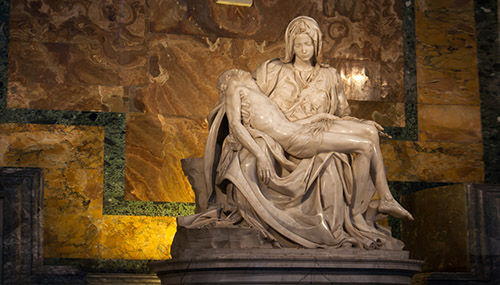my blog
Michelangelo's Pieta. The sculptural masterpiece of the 15th century.


private & group tours of Rome


In 1498 the Cardinal Jaen Bilhéres de Lagraulas of France arrived in Italy with the court of Charles VIII, the king of France, who commissioned to the young Michelangelo to curve a marble group. The work would last a year for a total cost of four hundred and fifty gold ducats, as per contract.
The Cardinal, obsessed with “greatness”, wanted to have a very prestigious funeral monument never done before.
According to the project, the sculptural group would be placed in the chapel of the kings of France, close to the transept of the old St. Peter’s Basilica. The chapel was a small temple dedicated to the virgin and martyr Santa Petronilla, daughter of Simon Peter. So, the young Michelangelo was really starting to create a work of extreme importance: “the Virgin Mary cradling her crucified son in her lap“. This work of art would have represented, to the cardinal, a memorial of his own nation and its glory. Michelangelo took his inspiration from the art of the Alps, in particular from the Germanic sculptural groups, called Vesperbilder, depicting the Virgin contemplating the body of her Son lying on her knees. Unfortunately, the Cardinal never saw it completed, because he died on August 6, 1499.
Entering the main door, you get to the central nave of St. Peter’s Basilica. Your glance takes upwards and gradually onto massive columns, colossal statues, marble decorations and suggestive rays of sun which, penetrating the Church, enhance the ethereal dimension. The feeling is so magical, perfect and full of wonder that it immediately leads you to discover the great treasure enclosed in this magnificent sacred place.
Let’s go to the chapel of the Pietà (in Italian, pietà means “pity”). The chapel houses a huge marble complex, the Pietà, created by Michelangelo Buonarroti, a young and promising Florentine sculptor.
Once inside the basilica, due to the large number of visitors, you need to carve out a small space to enter into dialogue with this great masterpiece. As you can see the marble group represents the theme of Pity, the Virgin Mary holding the body of her crucified son. Looking at the face of Virgin Mary, you can see a saddened face by the death of her son, but at the same time a great composure shining through. The bowed head as a sign of humility is an additional feature of Virgin. It means that she has accepted Divine Will, as reported by the Evangelist Luke in the verse in which the angel said to her: “Have no fear, Mary, for you have God’s approval. And see, you will give birth to a son, and his name will be Jesus. (Lk 1,30-31).
Right up to the present day, this masterpiece continues to be a source of wonder and fascination.
Now let’s look at the arms of the Virgin Mary who lovingly hold the dead body of her son. The palm of the left hand turned upwards is a clear invitation to those who look to feel the same pain for Jesus, who died for love, to free humanity from the yoke of sin and slavery.
The contemplation of this work of art continues, this time, from a technical point of view. Let’s look at the long, soft gown worn by the Verging Mary, the details of the veil and the naked, smooth and perfect body of Christ and finally the band that crosses diagonally the bust of the Virgin bearing the artist’s signature in latin: MICHEL.A [N] GELVS BONAROTVS FLORENT [INVS] FACIEBAT (In Italian, “The Florentine Michelangelo Buonarroti did it”).
The Vatican Pietà was the only work signed by Michelangelo. Legend has it, after hearing from some Milanese citizens saying that the work had been created by the Lombard artist Cristoforo Solari, known as Gobbo of Milan, Michelangelo made the decision to sign his masterpiece.
Through this work emerges the innate talent of Michelangelo, who did the Vatican Pietà at the age of 24-year-old. He managed to materialize a passage from Sacred Scripture, instilling credibility and faith in his own figures. Although the iconographic subject of the Pietà has been reproduced by many other artists, Michelangelo has depicted it in an unusual way. What is striking is the searching for balance and the ability to make concrete and evident the idea that he has in mind, creating a work that seems almost human. In addition, the theatrical effect that would have arisen when the light of the candles would mark the corners, lines and curves of the sculpture, as well as the shaded parts of the group are the great effects created by this talented young boy.
On May 21, 1972, a madman with a hammer entered St. Peter’s and began hacking away at the Pietà. After this, all the fragments that were lying on the ground were collected in order to repair the great damage. That’s way there’s now a shield of bulletproof glass in front of the sculpture.
Nowadays, the thousands of visitors and pilgrims who crowded the basilica every year, before the magnificence work of art, can’t only be deeply fascinated, since everything that is beautiful and intense is destined to last forever.
3th April 2020
Francesca Perna
© 2020 Rome and You. All rights reserved.
Necessary cookies are absolutely essential for the website to function properly. This category only includes cookies that ensures basic functionalities and security features of the website.
Any cookies that may not be necessary for the website to function and is used specifically to collect user personal data via analytics, ads, other embedded contents are termed as non-necessary cookies. It is mandatory to procure user consent prior to running these cookies on your website.